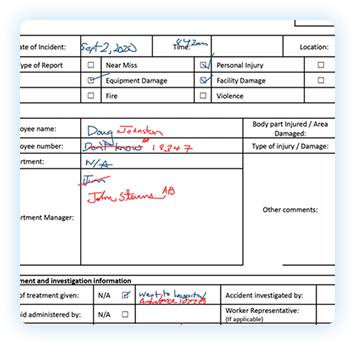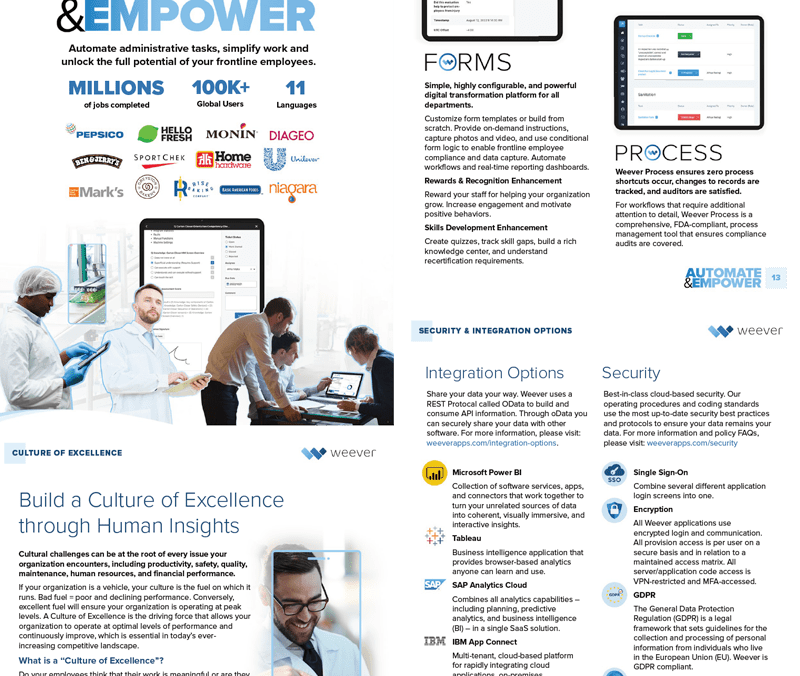The Problem with Paper
Weever is Operational Excellence Software that empowers the pursuit of perfection by enhancing operational visibility, collaboration and productivity in quality, maintenance, safety and production.
This article reviews the following topics:
THE CASE FOR DIGITIZATION
Why do paper forms limit factory operations and continuous improvement?
Manufacturers come in a lot of different shapes and sizes. There are massive, multinational corporations that produce millions of products a day. And there are small job shops that manually crank out a piece or 2 every week.
One thing all of these factories have in common is that they have all “digitized” operations in one way or another. The most basic form of digitization is using productivity software, like Microsoft Office, to digitize office operations.
However, most large manufacturers have digitized many elements of their factory operations as well. The reason for this is simple: paper forms have inherent inefficiencies that inhibit the continuous improvement and enhancements in productivity.

In an increasingly competitive global economy, manufacturers are constantly trying to improve operations. This means they want to manufacture the most products, to the highest level of quality (for those features their customers deem most important) and at the lowest possible price.
Capturing data on quality, maintenance, safety, production and other operational concerns is necessary to inform the process of continuous improvement. And many manufacturers still use paper forms to do this.
Paper was invented a millennium ago and it is still very useful, in the manufacturing operations context, for quick note making and brainstorming. The A3 continuous improvement process is even named after the size of paper recommended for the process.
However, there are many inherent issues with paper that inhibit the pursuit of Operational Excellence. Usually our customers come to us because they are using a process involving paper forms and spreadsheets to capture data from the floor, manage projects and generate reports. If this sounds familiar, you are not alone.
You might be reading this because you are looking for help to convince your management team that you need to invest in a software platform that digitizes operations. Here is a quick list of issues that you will find with paper forms.
1) Stagnant
“I don’t know what is happening when it happens.”
Paper forms are static and motionless in the sense that they can only exist in one place at a time. So while the operator has the form at the machine during the entire production run, supervisors, managers and other stakeholders have no idea what is happening until the form is physically submitted for processing.
The time difference between what is happening and when decision makers find out about it is called “Real-Time Lag”.
This can hinder operations because products can leave the facility before quality issues are detected, machines can run “hot” for too long causing breakdowns that could have been avoided, safety “near misses” can turn into incidents because they were not understood and corrected soon enough, and so on.

2) Waste Time
“It takes a lot of time to get what we need done.”
Usually, operators will keep the paper form at the machine during the production run and hand it in to the office when it is completed. Then an administrator will manually input the data into a spreadsheet and manually update the reports.
This process takes time and time is money. A lot of this manual administration is a repeated process that can be simply automated through digitization software, which will save on time and also money.

3) Errors
“The back-and-forth is killing us.”
Paper forms are a breeding ground for mistakes and omissions, which take time and energy to resolve. When most people who use paper forms talk about “inefficiency”, this is usually what they are referring to.
For example, the operator submits an abnormality form for maintenance to review. The technician reviews the form but cannot act because there is missing information. The tech tries to find the operator that reported the issue but they are on separate shifts. The result is that the abnormality report either never gets corrected or it takes a much longer time than it should for the work to be completed.

4) Inconsistent
“I don’t know if the work is getting done correctly.”
Compliance basically means that processes are adhered to, and this may be an internal SOP or a regulation that is a law. Paper forms can be “pencil whipped” and there is not way to connect what physically actually happened to what was written down except to trust that the person was being honest.
The path of least resistance is a very attractive one. In this case, the path of least resistance is to complete the paperwork but not actually do the thing.
Digital forms can help to ensure what is being documented is actually what happened with features like conditional logic, date/time stamps, location stamps, photo capturing, and more.

Hope this list helps you move your digitization project forward.
Weever is Operational Excellence Software that empowers the pursuit of perfection by enhancing operational visibility, collaboration and productivity in quality, maintenance, safety and production.
To learn more about how Weever can help you attain results in OpEx, please feel free to get in touch.

Learn about the Platform.
Download the brochure to get all the details about how Weever works.